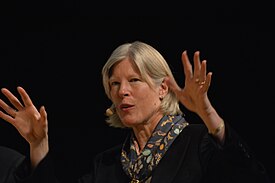Cynthia Kenyon
| Cynthia Kenyon | |
|---|---|
 |
|
| Born | February 21, 1954 |
| Fields | Biologist |
| Institutions | University of California, San Francisco (UCSF) |
| Alma mater | Massachusetts Institute of Technology |
| Doctoral advisor | Graham Walker |
| Notable students | Andrew Dillin |
| Known for | Aging in C. elegans |
| Notable awards |
National Academy of Sciences Dan David Prize |
Cynthia Jane Kenyon (February 21, 1954) is an American molecular biologist and biogerontologist known for her genetic dissection of aging in a widely used model organism, the roundworm Caenorhabditis elegans.
Cynthia Kenyon graduated valedictorian in chemistry and biochemistry from the University of Georgia in 1976. She received her PhD in 1981 from MIT where, in Graham Walker's laboratory, she was the first to look for genes on the basis of their activity profiles, discovering that DNA-damaging agents activate a battery of DNA repair genes in E. coli. She then did postdoctoral studies with Nobel laureate Sydney Brenner at the MRC Laboratory of Molecular Biology in Cambridge, England, studying the development of C. elegans.
Since 1986 she has been at the University of California, San Francisco (UCSF), where she was the Herbert Boyer Distinguished Professor of Biochemistry and Biophysics and is now an American Cancer Society Professor.
In April 2014, Kenyon was named Vice President of Aging Research at Calico, a new company focused on health, well-being, and longevity. Prior to that, she served as a part-time advisor beginning in November 2013. Kenyon will remain affiliated with UCSF as an emeritus professor.
Her early work led to the discovery that Hox genes, which were known to pattern the body segments of the fruit fly Drosophila, also pattern the body of C. elegans. These findings demonstrated that Hox genes were not simply involved in segmentation, as thought, but instead were part of a much more ancient and fundamental metazoan patterning system.
...
Wikipedia
